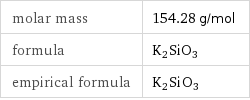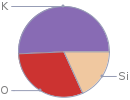Input interpretation

K2SiO3 (chemical compound)
Basic properties

molar mass | 154.28 g/mol formula | K2SiO3 empirical formula | K_2Si_O_3
Elemental composition

Find the elemental composition for K2SiO3 in terms of the atom and mass percents: atom percent = N_i/N_atoms × 100% mass percent = (N_im_i)/m × 100% Plan: • Write the chemical formula and gather atomic masses from the periodic table. • Determine values for N_i, m_i, N_atoms and m using these items. • Finally, compute the percents and check the results. Use the chemical formula to count the number of atoms, N_i, for each element and find the total number of atoms, N_atoms, per molecule: | number of atoms K (potassium) | 2 Si (silicon) | 1 O (oxygen) | 3 N_atoms = 2 + 1 + 3 = 6 Divide each N_i by N_atoms to calculate atom fractions. Then use the property that atom fractions must sum to one to check the work: | number of atoms | atom fraction K (potassium) | 2 | 2/6 Si (silicon) | 1 | 1/6 O (oxygen) | 3 | 3/6 Check: 2/6 + 1/6 + 3/6 = 1 Compute atom percents using the atom fractions: | number of atoms | atom percent K (potassium) | 2 | 2/6 × 100% = 33.3% Si (silicon) | 1 | 1/6 × 100% = 16.7% O (oxygen) | 3 | 3/6 × 100% = 50.0% Look up the atomic mass, m_i, in unified atomic mass units, u, for each element in the periodic table: | number of atoms | atom percent | atomic mass/u K (potassium) | 2 | 33.3% | 39.0983 Si (silicon) | 1 | 16.7% | 28.085 O (oxygen) | 3 | 50.0% | 15.999 Multiply N_i by m_i to compute the mass for each element. Then sum those values to compute the molecular mass, m: | number of atoms | atom percent | atomic mass/u | mass/u K (potassium) | 2 | 33.3% | 39.0983 | 2 × 39.0983 = 78.1966 Si (silicon) | 1 | 16.7% | 28.085 | 1 × 28.085 = 28.085 O (oxygen) | 3 | 50.0% | 15.999 | 3 × 15.999 = 47.997 m = 78.1966 u + 28.085 u + 47.997 u = 154.2786 u Divide the mass for each element by m to calculate mass fractions. Then use the property that mass fractions must sum to one to check the work: | number of atoms | atom percent | mass fraction K (potassium) | 2 | 33.3% | 78.1966/154.2786 Si (silicon) | 1 | 16.7% | 28.085/154.2786 O (oxygen) | 3 | 50.0% | 47.997/154.2786 Check: 78.1966/154.2786 + 28.085/154.2786 + 47.997/154.2786 = 1 Compute mass percents using the mass fractions: Answer: | | | number of atoms | atom percent | mass percent K (potassium) | 2 | 33.3% | 78.1966/154.2786 × 100% = 50.69% Si (silicon) | 1 | 16.7% | 28.085/154.2786 × 100% = 18.20% O (oxygen) | 3 | 50.0% | 47.997/154.2786 × 100% = 31.11%
Mass fraction pie chart

Mass fraction pie chart